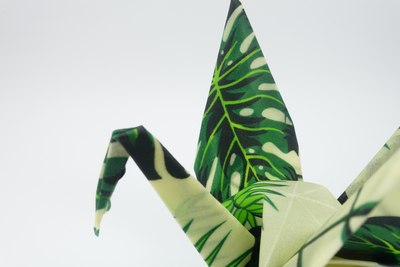Folding a Wax Wrapper (Woskowijka)

When I received a wax wrapper (Polish: woskowijka), I decided to give a try folding it. Wax wrappers are sheets of fabric soaked in beeswax, and advertised as a reusable, eco-friendly alternative to plastic food wrapping foil. Unsure how it would behave, I only folded a traditional crane so the experience is quite limited.
I was surprised that despite the fabric being quite thick compared to paper, it folded really well. The sheet was quite large, about 30 cm, but still I expected problems folding even a simple traditional model. To my surprise, this material held creases well, and I was able to make quite precise folds. I attribute this to the beeswax which stiffens the fabric and gives it good memory. Wax becomes soft from the warmth of your hands and then stiffens when it cools down (which happens quite quickly). Thus, while folding, the wax-soaked fabric is easily folded and shaped, but hardens into a solid shell when you stop touching it. In some ways this resembles wet folding or shaping models using MC. The disadvantage is the wax is a little bit sticky even when cold, so the model leaves tiny traces of wax on whatever it touches. It also emits a slight and rather pleasant smell.
Wax wrappers are quite expensive, so a sheet costs about as much as a good sheet of hand-made paper of comparable size. Even though the fabric becomes quite OK for folding due to the beeswax, it is still rather thick, so I don’t expect to be able to fold complex models from this stuff (but I have to try it some time). The fabric is usually printed, so there is a range of colors and patterns to choose from. Sheets are advertised as reusable, and indeed you can flatten a folded sheet and refold a different model. This works since the fabric itself has as well as no memory and so does not collect crease marks, and the wax is soft and can be redistributed over creases when its layer becomes thin somewhere due to folding.
Overall, this was a very interesting experience, and the folding, at least for a simple traditional model, went surprisingly well. If I get my hands on another piece, I want to try folding a more complex figurative model, and a grid-based model such as a tessellation. The finished crane looks attractive due to the pattern printed on the cloth and the beeswax giving it a unique, somewhat glossy finish, so I’m keeping it since it would be a pity to reuse the sheet for another model.
Comments